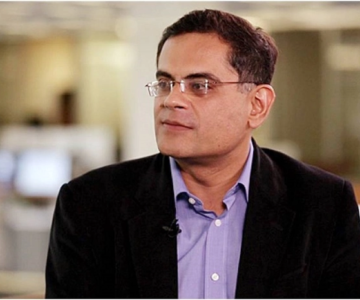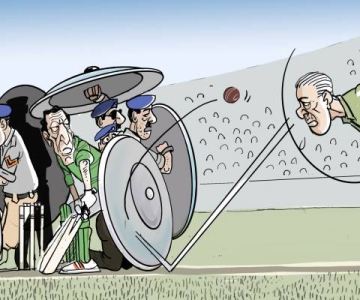The celebrated artiste Vidya Rao from Delhi has sent this tender and profound letter after reading my post on destruction of Buddhas in Swat (and the painting that was inspired by the vandalism). I am reproducing this letter with her permission as it adds to the debate and brings in a multi-religious and multicultural perspective that is close to my heart. Her words can be so moving:
But who can silence Silence? Who can erase Emptiness? The Buddha is, and yet is not, in the stone or metal representations of him. Nor is the truth of Islam contained within the structures of a mosque. It is not the Buddha or Islam or anything such that is destroyed. What is destroyed is the connection to the inner Buddha, the inner light. We are all the poorer for this, because form, the beauty of form, gives joy and love to our lives. The task is to both mourn, work in whatever way to prevent such destruction– but also to see this as yet another teaching on impermanence.
Here is the full text of the letter:
Just saw your painting and article on the Buddha, Taliban, Swat, and then by a feat of technological achievement (for me!) even traversed the web and read some of the comments.
As always your work, both as writer and painter is thought-provoking.
And the comments too have given me much to think about– especially regarding Buddha’s philosophy and the traditions of ‘idol-making’.
As for me, as someone who is quite deeply connected to this philosophy, this whole issue is significant. I remember when the Bamiyan Buddhas were destroyed– my dear friend and teacher Ramchandra Gandhi had spoken eloquently about the Buddhist principle of shunyata, the essential non-existence of phenomena, but that nevertheless exists in the relative world. …Yes indeed, there are traditions of Buddhism that worship idols, and where bhakti even is an important feature. In other traditions bhakti does not form a key part. One of the most beautiful of Buddhist texts–Shantideva’s ‘Bodhicharyavatara’ seems to me sometimes to be lyrical bhakti. Then there is the abstruse metaphysics of Chandrakirti and Nagarjuna!
As a child I was first drawn to Buddhism by its emphasis on equality, freedom from crippling dependence on ritual, and by its highly ethical eight-fold path. But for me something seemed incomplete, until, as a twenty-year-old I encountered Mahayana traditions. Here I found the vibrancy of art, and paradoxically, the beauty of ritual which in a sense erased itself. One of the most beautiful and moving ceremonies is the creation of the sand mandalas- of mystic diagrams drawn with sand over many days to the accompaniment of prayers and ritual music. The moment the mandala is finished, it is then ritually erased.
At the heart of Mahayana Buddhism is this teaching that everything is ephemeral and therefore nothing has innate existence– it changes as you see it, and that the truth about form is its shunyata, its emptiness. The beautiful Prajna Paramita Hridaya sutra says just this:
Form is emptiness, emptiness is form: roopam shunyata, shunyataiva roopam.
The destruction of form– I would add, of beloved form– for is not form the face of Laila, of Heer, of the Pir, of the Beloved and of the ordinary human beloved, of the flowers of spring and the raindrops of barkha…the destruction of that which gives us a way of ‘seeing emptiness’ is, what can I say?- the utmost wickedness. (The Buddha himself , though, would perhaps have said ‘the utmost ignorance’ not wickedness). For Babri Masjid, or Wali Dakkani’s mazaar, Ustad Fayyaz Khan Saheb’s mazaar, as much as the Buddha’s images in Swat, are but ways in which we have given form to the formless, ways by which we have made it possible to see shunyata, to hear silence. Babri Masjid, as much as the Bamiyan Buddhas are the face of Laila.
But who can silence Silence? Who can erase Emptiness? The Buddha is, and yet is not, in the stone or metal representations of him. Nor is the truth of Islam contained within the structures of a mosque. It is not the Buddha or Islam or anything such that is destroyed. What is destroyed is the connection to the inner Buddha, the inner light. We are all the poorer for this, because form, the beauty of form, gives joy and love to our lives. The task is to both mourn, work in whatever way to prevent such destruction– but also to see this as yet another teaching on impermanence.
My friend Ramu Gandhi would often tell an incident from the life of Vivekananda: In the temple of Ksheer Bhavani, the goddess, as he bemoaned the historical destruction of idols, Vivekananda asked the goddess why she, all powerful, had not prevented this destruction. It was then that he heard the voice of the goddess. ‘What is it to you’, Vivekananda heard her say ‘if my idols are destroyed? Do you protect me or do I protect you?‘
Raza, for every act of wanton destruction that the world witnesses, here are a hundred acts of faith and love. Your words and paintings, the thoughts and sharing of a community of friends– these ‘re-form’ the emptiness, giving us all again a space of truth and openness and love. So thank you for your words and pictures and thank you to all those who feel deeply enough to speak, weep, smile, create…
Vidya Rao



